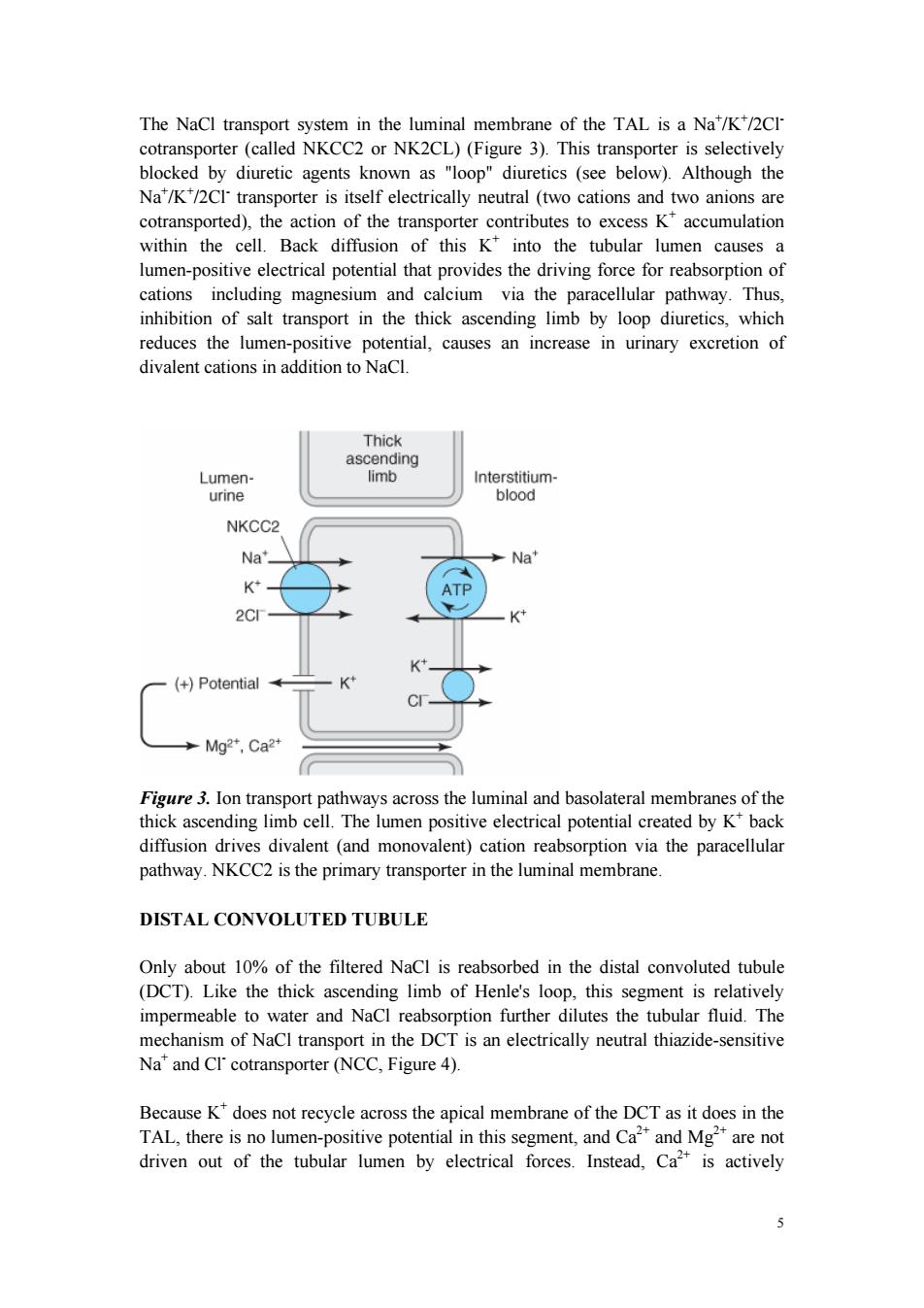正在加载图片...

The NaCl transport system in the luminal membrane of the TAL is a Na/K/2CI cotransporter(called NKCC2 or NK2CL)(Figure 3).This transporter is selectively blocked by diuretic agents known as "loop"diuretics (see below).Although the Na"/K/2CI transporter is itself electrically neutral (two cations and two anions are cotransported),the action of the transporter contributes to excess Kaccumulation within the cell.Back diffusion of this K into the tubular lumen causes a lumen-positive electrical potential that provides the driving force for reabsorption of cations including magnesium and calcium via the paracellular pathway.Thus, inhibition of salt transport in the thick ascending limb by loop diuretics,which reduces the lumen-positive potential,causes an increase in urinary excretion of divalent cations in addition to NaCl. Thick ascending Lumen- limb Interstitium- urine blood NKCC2 Na Na" K 2CI (+)Potential Mg2*,Ca2* Figure 3.Ion transport pathways across the luminal and basolateral membranes of the thick ascending limb cell.The lumen positive electrical potential created by K back diffusion drives divalent (and monovalent)cation reabsorption via the paracellular pathway.NKCC2 is the primary transporter in the luminal membrane. DISTAL CONVOLUTED TUBULE Only about 10%of the filtered NaCl is reabsorbed in the distal convoluted tubule (DCT).Like the thick ascending limb of Henle's loop,this segment is relatively impermeable to water and NaCl reabsorption further dilutes the tubular fluid.The mechanism of NaCl transport in the DCT is an electrically neutral thiazide-sensitive Na"and CI cotransporter(NCC,Figure 4). Because K does not recycle across the apical membrane of the DCT as it does in the TAL,there is no lumen-positive potential in this segment,and Caand Mg2are not driven out of the tubular lumen by electrical forces.Instead,Ca2 is actively 55 The NaCl transport system in the luminal membrane of the TAL is a Na+ /K+ /2Clcotransporter (called NKCC2 or NK2CL) (Figure 3). This transporter is selectively blocked by diuretic agents known as "loop" diuretics (see below). Although the Na+ /K+ /2Cl- transporter is itself electrically neutral (two cations and two anions are cotransported), the action of the transporter contributes to excess K+ accumulation within the cell. Back diffusion of this K+ into the tubular lumen causes a lumen-positive electrical potential that provides the driving force for reabsorption of cations including magnesium and calcium via the paracellular pathway. Thus, inhibition of salt transport in the thick ascending limb by loop diuretics, which reduces the lumen-positive potential, causes an increase in urinary excretion of divalent cations in addition to NaCl. Figure 3. Ion transport pathways across the luminal and basolateral membranes of the thick ascending limb cell. The lumen positive electrical potential created by K+ back diffusion drives divalent (and monovalent) cation reabsorption via the paracellular pathway. NKCC2 is the primary transporter in the luminal membrane. DISTAL CONVOLUTED TUBULE Only about 10% of the filtered NaCl is reabsorbed in the distal convoluted tubule (DCT). Like the thick ascending limb of Henle's loop, this segment is relatively impermeable to water and NaCl reabsorption further dilutes the tubular fluid. The mechanism of NaCl transport in the DCT is an electrically neutral thiazide-sensitive Na+ and Cl- cotransporter (NCC, Figure 4). Because K+ does not recycle across the apical membrane of the DCT as it does in the TAL, there is no lumen-positive potential in this segment, and Ca2+ and Mg2+ are not driven out of the tubular lumen by electrical forces. Instead, Ca2+ is actively